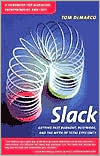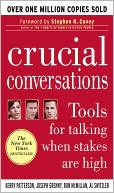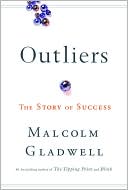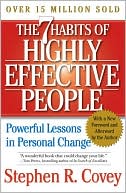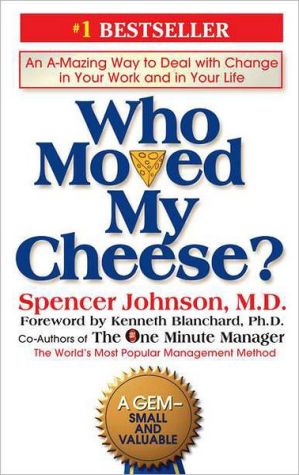Slack: Getting Past Burnout, Busywork, and the Myth of Total Efficiency
If your company’s goal is to become fast, responsive, and agile, more efficiency is not the answer—you need more slack.\ Why is it that today’s superefficient organizations are ailing? Tom DeMarco, a leading management consultant to both Fortune 500 and up-and-coming companies, reveals a counterintuitive principle that explains why efficiency efforts can slow a company down. That principle is the value of slack, the degree of freedom in a company that allows it to change. Implementing slack...
Search in google:
To most companies, efficiency means profits and growth. Publishers Weekly DeMarco (Peopleware), a management consultant, says that in today's competitive, fast-moving economy, managers work far less effectively than before. Responding to restructuring and staff reductions, managers overemphasize deadlines and rush employees, sacrificing quality. Instead, says DeMarco, executives should encourage teamwork, discourage competition and allow training time. Unfortunately, tedious, jargon-heavy writing dulls DeMarco's worthwhile message. (May) Copyright 2001 Cahners Business Information.
1: Madmen in the Halls\ The legacy of the nineties has been a dangerous corporate delusion: the idea that organizations are effective only to the extent that all their workers are totally and eternally busy. Anyone who's not overworked (sweating, staying late, racing from one task to the next, working Saturdays, unable to squeeze time for even the briefest meeting till two weeks after next) is looked on with suspicion. People with a little idle time on their hands may not even be safe. As one of my friends at Digital Equipment Corporation told me during the company's darkest days, "There are madmen in the halls, looking for someone to ax." Of course, the ones they were looking to ax were the folks who weren't all that busy.\ Crisis of Confidence\ Your company may not now have actual ax-wielding crazies roaming the halls, but their specter is almost certainly still with you. This is the remnant of the crisis of confidence we've just come through. Consider: As this is being written, American and western European business is in a period of extraordinary prosperity. The rest of the world is a basket case and we are healthier than we've ever been. And yet just a few short years ago, we were all in an agony of doubt. How could we survive, we wondered, against the competition of the ravenous third world, willing to work for peanuts and liable to undersell us in any market anywhere? How could we stay even with the superbly educated Japanese, or those clever and hungry workers coming out from behind the Iron Curtain, or the Taiwanese and Koreans with their superhuman work ethic and their awesome skills? Acting on our doubts, we went through a purge of excess capacity (i.e., people with homes and families). We trimmed as though our very survival depended on trimming.\ Wasn't it reasonable to put our house in order in this fashion? Maybe it was in the short run. It probably contributed at least somewhat to our present strength. Yet the lasting side effect of the purge–the notion that busyness is the essence of business–can only do us long-term harm.\ The Price of "Putting Our House in Order"\ During the last ten years we have downsized, "right-sized," laid off, and fired people's butts. We have cut payrolls, closed plants, sold off divisions, and generally scared all our remaining employees to death. We nodded in approval as characters like Chainsaw Al (at one time the worst CEO in America) did their dirty work. We bid up the stocks of companies like AT&T who led the trend, i.e., led the retreat.\ The principal target of the cuts has been that bugaboo of organizational efficiency: middle management. We asked ourselves, "What are they, after all, those middle managers? What are they but fat? What do they really exist for other than to be cut out in the interest of efficiency?" And so we cut. We surgically removed the middle layers of our organizations, flattening the charts and widening the scope of management at each level.\ Was that a good thing to do? I have my doubts.\ Maybe middle management exists for some reason above and beyond filling the space between the top and the bottom of the hierarchy. Part of my purpose in this book is to examine what's supposed to happen in the middle of a healthy organization, the critical role of middle management.\ The main activity of those managers is reinvention. It is the middle of the organization where reinvention takes place. This is where the dynamic of today's organizational functioning is examined, taken apart, analyzed, resynthesized, and assembled back into new organizational models that allow us to move forward.\ What got cut out of the most aggressively purged organizations is the capacity to change. The so-called restructurings have, in most cases, optimized the present steady state, only at the expense of the future.\ Does It Matter?\ Well, so what? Some companies have always been prone to trade away the future to make the present look a little more rosy. In the short term they prosper, and in the long term they don't. What's different this time? The difference is that today even the companies that didn't cut the heart out of their effective change centers have made it more difficult for those centers to operate. Change and reinvention require a commodity that is absent in our time as it never has been before. That commodity–the catalytic ingredient of all change–is slack. Slack is the time when reinvention happens. It is time when you are not 100 percent busy doing the operational business of your firm. Slack is the time when you are 0 percent busy.\ Slack at all levels is necessary to make the organization work effectively and to grow. It is the lubricant of change. Good companies excel in the creative use of slack. And bad ones can only obsess about removing it.\ 2: Busyness\ Imagine that you took on an assignment to direct a film about happenings inside a hugely successful company. How would you portray the company? How, in particular, would you make it look successful? One tempting answer is to convey its great success by showing everyone who works there to be immensely busy all the time. After all, you might reason, how would the company have become so successful if its people weren't putting in substantial extra effort?\ My own experience consulting inside some highly successful companies (Microsoft, Apple, Hewlett-Packard, IBM, Dupont, to name a few) cannot corroborate a relationship between busyness and success. Very successful companies have never struck me as particularly busy; in fact, they are, as a group, rather laid-back. Energy is evident in the workplace, but it's not the energy tinged with fear that comes from being slightly behind on everything. The companies I have come to admire most show little obvious sense of hurry. They are more like an extended family, embarked upon a project whose goal is only partly expressed in getting something done; the other part of the goal is that all involved learn and grow and enjoy themselves along the way.\ Work, particularly knowledge work, can be extremely enjoyable. That's why so many of us become addicted to it. If you take sensual pleasure in your work, and those around you are doing the same thing, if it's clearly okay in your corporate culture to enjoy what you're doing, chances are that yours is a company headed toward success. Sign up for the stock plan.\ The Busy Worker\ Extreme busyness is injurious to the real work of the organization. I will make that point as carefully as I can in the chapters to follow, stressing the effect in particular on management. But first, I ask you to consider how busyness may hurt the effectiveness of even the lowest-level workers.\ Take, for example, the secretary. (You remember secretaries, don't you? A once-common element of corporate life.) A secretary's job may involve document preparation, appointment scheduling, coordinating, and generally facilitating the smooth functioning of one manager's work life–let's say yours. We'll call her Sylvia.\ A good secretary is a treasure, as anyone who has ever worked with one knows, and Sylvia is definitely a treasure. With Sylvia around, everything goes more smoothly. When you're away from the office–it never looks this way officially, but whom are we kidding?–Sylvia is effectively in charge. She is the one who coordinates and distributes work to be done. If she ever left, it would set you and your organization back a few months, at least.\ But now into this happy scenario drop a consultant with a charter to reduce cost, the "corporate restructuring agent." Whoa, he says, what's this? A secretary? And what's she up to this very minute? He parks himself beside Sylvia's desk with his trusty stopwatch in hand. To no one's surprise, he finds that Sylvia is really only busy 43 percent of the time. The rest of the time she is . . . available. She's available to do stuff that you or your people find you need to have done. That's part of what's so great about Sylvia: When something comes up, she can usually get cracking on it right away.\ A look of triumph now comes over the consultant's face. If Sylvia is only busy 43 percent of the time, 57 percent of her cost is potentially savable. Why, all we have to do is dump Sylvia into a "pool" and allocate 43 percent of her time to you and the rest to other people. Or have you share her with some other manager who needs only 57 percent of a full person. Or even get rid of Sylvia entirely and hire a temp for that 43 percent of the time that you really need someone. (You can be sure that the consultant will be checking back later to find out if you really need that much help.)\ What an improvement. Sylvia's gone or gone 57 percent of the time, and 57 percent of what she was costing the organization goes directly down to the bottom line. Wow. In place of a person who was idle 57 percent of the time, we now have someone who is busy 100 percent of the time. Talk about efficiency!\ The problem, of course, is that the now-slackless secretary or portion thereof is simply not as responsive as Sylvia was. This highly efficient person doesn't get cracking right away on anything new that comes up, because this highly efficient person is too busy.\ How We Work Together\ Modern organizations are huge networks of interconnected work. The nodes of this network are you and your coworkers. The connections are pieces of work in progress that get passed from one person to another.\ As a practical matter it is impossible to keep everyone in the organization 100 percent busy unless we allow for some buffering at each employee's desk. That means there is an in-box where work stacks up.\ With enough buffer at each desk, the work flow can now be organized to keep everyone busy all the time.\ A side effect of this optimally efficient scheme is that the net time for work to pass through the organization must necessarily increase. Think of it from the work's point of view: The time it takes to move entirely through the network is increased by each pause it has to make in someone's in-basket. If workers were available when the work arrived at their desks, there would be no wait and the total transit time would be reduced. But availability implies at least some inefficiency, and that's what our efficiency program has drummed out of the organization.\ Making efficient use of workers in the sense of removing all slack from their day has an attendant cost in responsiveness and results directly in slowing the organization down. This is not an entirely happy tradeoff. As Bill Gates testified in the early proceedings of the Microsoft trial, "In the past, only the fittest would survive. Today, only the fastest will survive."\ It's possible to make an organization more efficient without making it better. That's what happens when you drive out slack. It's also possible to make an organization a little less efficient and improve it enormously. In order to do that, you need to reintroduce enough slack to allow the organization to breathe, to reinvent itself, and to make necessary change.\ 3: The Myth of Fungible Resource\ Typical restructuring efforts concentrate on making a company more efficient. I have argued that the potential to do harm in this endeavor is substantial. In other words, improving efficiency may in many cases be countereffective. But that is not to imply that improving efficiency is therefore easy. It isn't. In fact, it takes a huge amount of work and real ingenuity. It's hard to make an organization more efficient because the workers of that organization have been constantly trying to make themselves more efficient. They've been doing that for years, since they are frustrated by waste and bored by idleness. The efficiency expert who now comes into the organization is obliged to plow over terrain that has been plowed over by many thoughtful persons before. Up against this daunting challenge, who can blame him if he takes the odd shortcut from time to time to show a little apparent progress?\ The Oddest Shortcut of All\ The tendency to shortcut is further encouraged by the sense–almost always present when restructuring is in the air–that apparent progress is every bit as good as actual progress. Dividing Sylvia between two bosses, for example, is only apparent progress, since her improved efficiency is offset by her reduced responsiveness. But if the efficiency expert has only a week to trim the fat . . . Well, you can understand the temptation.\ So what's a useful shortcut for an efficiency expert who needs to show some quick organizational "improvement"? The shortcut that is most frequently employed is to assume that individual workers are entirely fungible....
PreludePt. 1Slack1Madmen in the Halls32Busyness73The Myth of Fungible Resource124When "Hurry Up" Really Means "Slow Down"225Managing Eve266Business Instead of Busyness33Pt. 2Lost, but Making Good Time7The Cost of Pressure458Aggressive Schedules549Overtime5910A Little Sleight of Hand in the Accounting Department7111Power Sweeper7512The Second Law of Bad Management8013Culture of Fear8614Litigation9315Process Obsession10216Quality11117Efficient and/or Effective12218Management by Objectives126Pt. 3Change and Growth19Vision13320Leadership and "Leadership"13721Dilbert Reconsidered14222Fear and Safety14623Trust and Trustworthiness15024Timing of Change15525What Middle Management Is There For15926Where Learning Happens16327Danger in the White Space17328Change Management181Pt. 4Risk and Risk Management29Uncommon Sense18930Risk Management: The Minimal Prescription19831Working at Breakneck Speed20432Learning to Live with Risk209Afterword33The Needle in the Haystack217Index221
\ From Barnes & NobleWant your business to have the flexibility and agility needed survive over the long haul? Then cut your workers some slack, advises consultant Tom DeMarco. "Change and reinvention require a commodity that is absent in our time as it never has been before. That commodity -- the catalytic ingredient of all change -- is slack. Slack is the time when reinvention happens. It is time when you are not 100 percent busy doing the operational business of your firm. Slack is the time when you are 0 percent busy." So, if you're willing to trade a small dip in efficiency for a big jump in effectiveness, give this contrarian work a look. \ Highlights:\ \ Examines the "unfortunate tradeoff" between efficiency and flexibility. DeMarco's basic argument is that organizations get more efficient only by sacrificing their ability to change -- and that slack is the best remedy for overcoming the latter shortcoming.\ Explores the four major benefits of slack: increased organizational agility; better retention of key personnel; an improved ability to invest in the future; and a capacity for sensible risk-taking, instead of risk-avoidance.\ Targets knowledge managers and workers who believe "the slack that has been squeezed out of your organizations over the last 10 years now has to be reintroduced, or no further meaningful progress will ever be possible."\ \ Advantages:\ \ DeMarco believes his book will appeal to those who are overworked and extremely busy. Consequently, he structured it to be a "very fast, very pointed" read.\ The author is a high-profile consultant who has worked with such companies as Apple, IBM, Hewlett-Packard, and Microsoft. Drawing from those experiences, DeMarco writes in an authoritative and accessible style.\ \ Related Titles:\ While exploring the tradeoff between efficiency and flexibility, DeMarco offers this quote from Microsoft's Bill Gates: "In the past, only the fittest would survive. Today, only the fastest will survive." For more on Gates' beliefs. DeMarco praises Scott Adams' "Dilbert" cartoon for offering "insight and wisdom on nearly a daily basis ... with a delightful twist of humor." If you can use a dose of Dilbert, try The Dilbert Future: Thriving on Stupidity in the 21st Century and Dilbert Gives You the Business. DeMarco is author or co-author of seven books on management and technical development methods, including Peopleware: Productive Projects and TeamsThe Deadline: A Novel about Project Management and Why Does Software Cost so Much? And Other Puzzles of the Information Age.\ Reviewed by MH - April 17, 2001\ \ \ \ \ \ Publishers Weekly\ - Publisher's Weekly\ DeMarco (Peopleware), a management consultant, says that in today's competitive, fast-moving economy, managers work far less effectively than before. Responding to restructuring and staff reductions, managers overemphasize deadlines and rush employees, sacrificing quality. Instead, says DeMarco, executives should encourage teamwork, discourage competition and allow training time. Unfortunately, tedious, jargon-heavy writing dulls DeMarco's worthwhile message. (May) Copyright 2001 Cahners Business Information.\ \ \ Library JournalInternational consultant DeMarco (Peopleware) presents his views on how corporations can become more effective. He states that in an age of acceleration, in which more work is crammed into less time, knowledge workers need slack time for reinvention, creativity, and growth. Slack time here is defined as "zero percent busy" and knowledge work is "think-intensive." The author offers his philosophy to all levels of management and gets to the core of what he thinks is wrong with today's modern corporations. Some of the problems he addresses include operating with meager staff, extended overtime, and unnecessary organizational meetings. His contention is that too many meetings take away from normal workday hours and create a need for managers and workers alike to incur overtime. While his views may sound innovative, they appear to be unrealistic and provide little direction for management trying to figure out how to keep with the competition. A marginal purchase for public libraries with business collections. Bellinda Wise, Nassau Community Coll. Lib., Garden City, NY Copyright 2001 Cahners Business Information.\ \ \ \ \ Soundview Executive Book SummariesChange has become the organizational mantra in today's fast-paced and increasingly global marketplace. But too often this need to change and adapt is confused with keeping employees busy all of the time and achieving total efficiency. Constant overtime and aggressive schedules are symptomatic of the "Hurry Up" organization. Efficiency is pitted against effectiveness, minimizing cost against minimizing time. Middle management has been squeezed so that there is less management and more "on task" efforts.\ What gets lost in this "Hurry Up" organization is the time it takes to think up new procedures or products; in other words, slack. In today's knowledge-based economy, unlike the factory-based model of prior centuries, creative management of slack is essential for a healthy, growing organization. Tom DeMarco explores some of the most common, diehard management theories and shows how they are inappropriate for today's knowledge-worker-based economy. He then shows organizations how they can create productive slack.\ Today's economy is based on knowledge workers; their needs are fundamentally different from the factory work force, or even the office work force of more predictable times. DeMarco writes that forcing knowledge workers to conform to an overly efficient work flow system is detrimental to their effectiveness - and, eventually to the overall ability of a company to be flexible enough to meet the demands of a constantly changing, increasingly global market.\ In a typical day, employees change tasks any number of times. With downsizing, fewer employees are expected to do more work, thus increasing the amount of daily task-switching. While fewer employees might look cost-effective at first glance, what is often overlooked is the true penalty that task-switching incurs with knowledge workers. DeMarco writes that this task-switching penalty is usually higher than any projected cost savings.\ Creative work involves a few intangible phases, such as conceptualizing and immersion. DeMarco explains that conceptualizing provides the base for knowledge work, and immersion involves the time writers, researchers, inventors, analysts or programmers need to mentally prepare themselves for their work. He writes that interruption of these intangible phases adds to the task-switching penalty.\ The Myth of Fungible Resources\ DeMarco explains that the reason task-switching penalties are ignored is because employees are seen as "fungible resources." Fungible can be described as being freely exchangeable or replaceable, in whole or in part, for another of like kind. He writes that knowledge workers are not fungible. To do their work effectively, they need slack time to cover the task-switching penalties as well as the immersion and conceptualizing phases.\ Besides time slack, DeMarco writes that knowledge workers also require "control" slack. Unlike previous blue-collar work forces, today's knowledge workers value challenges in their jobs as much as pay. They want to be constantly growing their careers. Managers must find ways to motivate these workers beyond pay. DeMarco writes that managers need to find ways to offer knowledge workers choices that will not only achieve the corporation's goals, but also their own growth needs.\ Knowledge workers have an intrinsic need for slack time for the conceptualizing and immersion process phases. According to DeMarco, using slack to give knowledge workers room for these intangible needs is nothing less than an investment in your human capital. Without slack, your employees will not have time to adapt to changes in the marketplace, and your company can lose its inventiveness.\ In the knowledge-based economy, all employees matter. Not every employee is a star performer and some employees will always need to be reassigned or even fired, but the costs in time and money of replacing any employee can be staggering.\ The Price of Aggressive Scheduling\ It is not uncommon for workers today to be under enormous deadline pressures. Such "aggressive" schedules, which often lead to overtime on a regular basis, are meant to get results faster and cheaper, but they mostly end up creating unhealthy stress. Across the organization, such constant stress results in reduced effectiveness, employee burnout and increased staff turnover.\ Today's knowledge workers by definition spend much of their time thinking. Routinely staying late to meet unrealistic deadlines robs them not only of needed sleep, but also their own private time. DeMarco reminds employers that tired, grumpy employees do not think as sharply as well-rested employees. In fact, studies have shown that longer days do not accomplish more than shorter ones. Stressed workers feel used and begin looking for new jobs.\ DeMarco writes that organizations that want to change, learn and grow require vision, leadership and timing. Slack is the lubricant that makes all of these possible.\ He writes that the key role of middle management is to lead the company through change. While change initiatives do need direction and support from the top office, if managers at the next level down are not empowered to work together or are not given the time to work on the change, change will wither on the vine. Managers who are isolated and overworked on day-to-day tasks cannot lead change initiatives and help the company to reinvent itself. Companies need to allow some slack time for managers to devote to reinvention.\ Why Soundview Likes This Book\ DeMarco addresses and debunks many popular myths about restructuring and downsizing with a clearer perspective of organizational improvement. Offering a pragmatic approach to helping managers see their employees as humans, and not machines, Slack provides numerous examples to back up his ideas about efficiency, flexibility, change and growth. Copyright (c) 2002 Soundview Executive Book Summaries\ \ \
